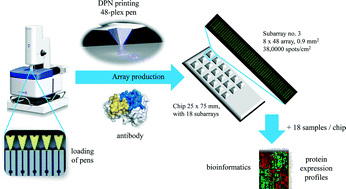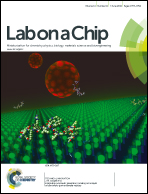Multiplexing of miniaturized planar antibody arrays for serum protein profiling – a biomarker discovery in SLE nephritis†
Abstract
In the quest to decipher disease-associated biomarkers, miniaturized and multiplexed antibody arrays may play a central role in generating protein expression profiles, or protein maps, of crude serum samples. In this conceptual study, we explored a novel, 4-times larger pen design, enabling us to, in a unique manner, simultaneously print 48 different reagents (antibodies) as individual 78.5 μm2 (10 μm in diameter) sized spots at a density of 38 000 spots cm−2 using dip-pen nanolithography technology. The antibody array set-up was interfaced with a high-resolution fluorescent-based scanner for sensitive sensing. The performance and applicability of this novel 48-plex recombinant antibody array platform design was demonstrated in a first clinical application targeting SLE nephritis, a severe chronic autoimmune connective tissue disorder, as the model disease. To this end, crude, directly biotinylated serum samples were targeted. The results showed that the miniaturized and multiplexed array platform displayed adequate performance, and that SLE-associated serum biomarker panels reflecting the disease process could be deciphered, outlining the use of miniaturized antibody arrays for disease proteomics and biomarker discovery.


 Please wait while we load your content...
Please wait while we load your content...